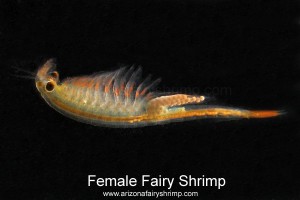Fairy Shrimp
Redtail Fairy Shrimp (female) from http://www.arizonafairyshrimp.com/photo.html
Fairy shrimp are a class of crustacean that is usually a quarter of an inch to a inch in length. Their exoskeleton is thin and flexible. Most species have a highly segmented body with three parts: head, thorax and abdomen. The head has two compound eyes, each located on the end of a prominent stalk, and two pairs of antennae. The second pair of antennae is longer. In males these longer antennae are specialized for holding the female during mating although few species reproduce by parthenogenesis. Fairy shrimp have 11 pairs of leaf-like phyllopodia (swimming legs) along their thorax that move in a synchronized rhythmic manner (metachronal) to propel them gracefully through the water. They live in vernal or ephemeral pools but can survive in hypersaline lakes, desert pools, and even icy waters. They swim “upside-down” (ventral side facing the water’s surface) either filtering organic materials from the water or obtaining algae from the surface of submerged rocks. According to Transactions of the Kansas Academy of Science, Fairy shrimp could be found in eastern Kansas before 1950 in “small pools in roadside ditches, along railroad fills, in drainage canals in floodplains and in pastures and woodlands are of frequent occurrence; these pools are richly supplied with vegetation which makes excellent culture media for small crustacean animals.” They are an important food source for fish and birds. Pintails and mallards feed on them in the Prairie Pothole Region of the Great Plains. For a more interesting details about Fairy shrimp visit the vernalpool.org.

